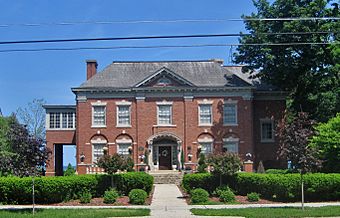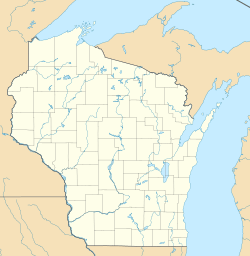Third Avenue Historic District (Kenosha, Wisconsin) facts for kids
Quick facts for kids |
|
|
Third Avenue Historic District
|
|

The Harold W. Jeffrey House (1909)
|
|
| Location | Along Third Ave. between 61st and 66th Sts., Kenosha, Wisconsin |
|---|---|
| Area | 21 acres (8.5 ha) |
| Architect | Richard Philipp, N. Max Dunning, Pond & Pond |
| Architectural style | Mid 19th Century Revival, Late 19th And 20th Century Revivals, Late Victorian |
| NRHP reference No. | 88002022 |
| Added to NRHP | November 1, 1988 |
The Third Avenue Historic District in Kenosha, Wisconsin, United States, is a special neighborhood known for its amazing, large homes. These beautiful houses, often called mansions, were built in the early 1900s. You can find most of them along the shores of Lake Michigan. This district shows off the fancy style of homes from that time.
Contents
History of the Third Avenue District
Early Days in Kenosha
The city of Kenosha, Wisconsin began to be settled in 1835. Just one year later, in 1836, a man named Charles Durkee bought a lot of land near Lake Michigan. Later, Durkee divided his large land holdings into smaller pieces. These smaller pieces were then sold for people to build houses on.
By 1882, the entire area that is now the Third Avenue district was settled. However, not many of the original buildings from that early time are still standing today.
Rise of Mansion Row
Starting around 1899, with the building of the George A. Yule House, Third Avenue became a very popular place to live. It was especially desired by Kenosha's most important and wealthy families. The 1890s were a time of great success for Kenosha. Many big companies brought money and jobs to the city.
Some of these important companies included:
- Simmons Manufacturing
- Bain Wagon Works
- N. R. Allen & Sons Tannery
- Chicago Brass Company
- Pettit Malting Company
These companies helped Kenosha grow and made many families rich.
Famous Architects and Their Designs
The wealthy families living in the Third Avenue Historic District hired well-known architects to design their homes. These architects created the unique and stylish look of the neighborhood.
Richard Philipp's Work
One of these architects was Richard Philipp. He designed the beautiful Alford House in the district. Philipp is also famous for designing the large estate of Walter J. Kohler in Kohler.
N. Max Dunning's Country Homes
Another architect was N. Max Dunning. He was born in Kenosha and was known for designing country-style houses. Dunning planned both the Fred H. Carpenter House and the Eugene Head House in the district.
Pond & Pond's Contributions
The most active architecture firm in the area was Pond & Pond. They designed several important homes in the district, including:
- The Jeffrey Nash House
- The Yule House
- The Wilson House
- The Allen House
Important People Who Lived Here
Many important business leaders and politicians lived in the Third Avenue Historic District.
Charles Durkee: Politician and Governor
Charles Durkee was one of the first people to own land here. He became a very important politician in Kenosha. He served two terms in the United States House of Representatives. He also served one term as a United States Senator. Later, Durkee moved to the Utah Territory to become its sixth governor. His house in Kenosha was bought by the Episcopal church in 1865. It then became part of Kemper Hall, which was a school for girls.
Charles W. Nash: Car Company Leader
Charles Williams Nash was another famous resident. He bought the Thomas B. Jeffery Company in 1916. He then changed its name to Nash Motors, which became a well-known car company.
Charles T. Jeffery: Automobile Innovator
Charles T. Jeffery was the son of Thomas B. Jeffery. He took over his father's company, the Thomas B. Jeffery Company, in 1910. This was the company that Nash later bought.
Charles C. Allen: Tannery Success
Charles C. Allen inherited his father's tannery business. He made it into a company that was known all over the country for making hosiery.
Becoming a Historic District
On November 1, 1988, the Third Avenue Historic District received special recognition. The National Park Service officially listed it on the National Register of Historic Places. This means the district's history and architecture are protected and celebrated.



